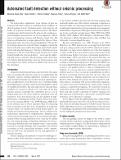Automated fault detection without seismic processing
Author(s)
Araya-Polo, Mauricio; Dahlke, Taylor; Frogner, Charlie; Hohl, Detlef; Zhang, Chiyuan; Poggio, Tomaso A; ... Show more Show less
DownloadAutomated fault detection.pdf (2.477Mb)
PUBLISHER_POLICY
Publisher Policy
Article is made available in accordance with the publisher's policy and may be subject to US copyright law. Please refer to the publisher's site for terms of use.
Terms of use
Metadata
Show full item recordAbstract
For hydrocarbon exploration, large volumes of data are acquired and used in physical modeling-based workflows to identify geologic features of interest such as fault networks, salt bodies, or, in general, elements of petroleum systems. The adjoint modeling step, which transforms the data into the model space, and subsequent interpretation can be very expensive, both in terms of computing resources and domain-expert time. We propose and implement a unique approach that bypasses these demanding steps, directly assisting interpretation. We do this by training a deep neural network to learn a mapping relationship between the data space and the final output (particularly, spatial points indicating fault presence). The key to obtaining accurate predictions is the use of the Wasserstein loss function, which properly handles the structured output — in our case, by exploiting fault surface continuity. The promising results shown here for synthetic data demonstrate a new way of using seismic data and suggest more direct methods to identify key elements in the subsurface.
Date issued
2017-03Department
Massachusetts Institute of Technology. Department of Brain and Cognitive Sciences; Massachusetts Institute of Technology. Department of Electrical Engineering and Computer ScienceJournal
The Leading Edge
Publisher
Society of Exploration Geophysicists
Citation
Araya-Polo, Mauricio, Taylor Dahlke, Charlie Frogner, Chiyuan Zhang, Tomaso Poggio, and Detlef Hohl. “Automated Fault Detection Without Seismic Processing.” The Leading Edge 36, no. 3 (March 2017): 208–214 © 2017 Society of Exploration Geophysicists
Version: Final published version
ISSN
1070-485X
1938-3789